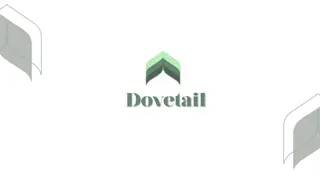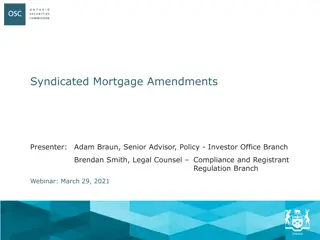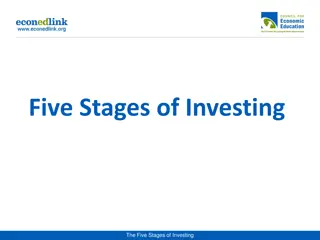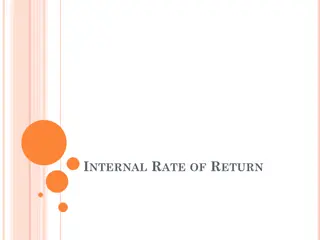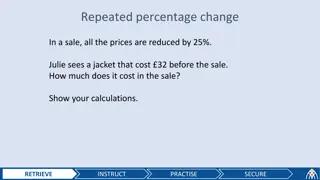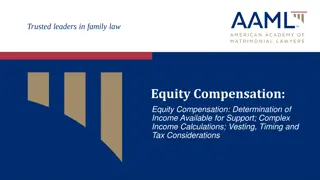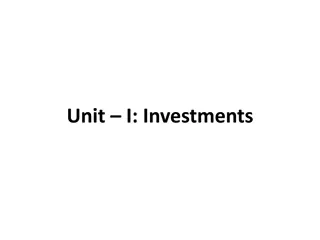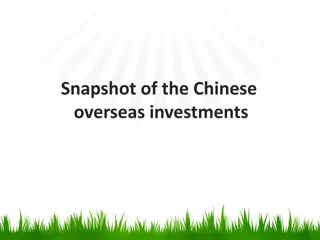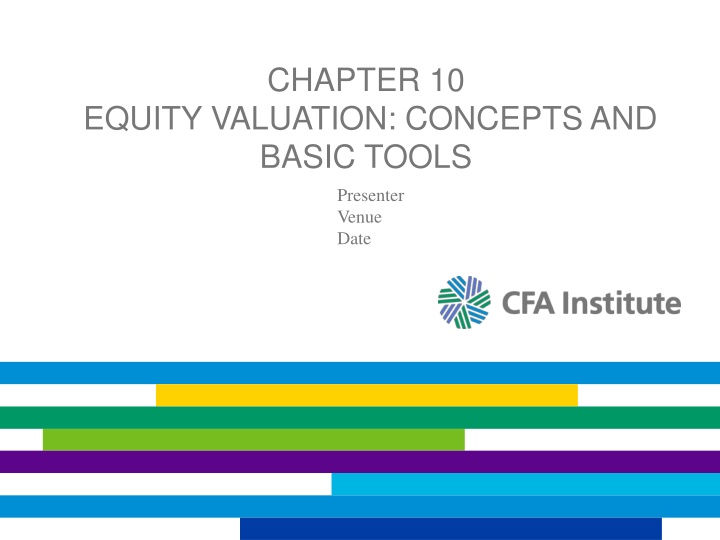
Equity Valuation Concepts and Tools - Understanding Value and Price
Explore the key concepts in equity valuation, such as intrinsic value versus market price, dealing with uncertainty, major categories of valuation models, present value models, preferred stock valuation, the impact of options on share price, the Gordon Growth Model, and when to use it for valuing equity.
Download Presentation

Please find below an Image/Link to download the presentation.
The content on the website is provided AS IS for your information and personal use only. It may not be sold, licensed, or shared on other websites without obtaining consent from the author. If you encounter any issues during the download, it is possible that the publisher has removed the file from their server.
You are allowed to download the files provided on this website for personal or commercial use, subject to the condition that they are used lawfully. All files are the property of their respective owners.
The content on the website is provided AS IS for your information and personal use only. It may not be sold, licensed, or shared on other websites without obtaining consent from the author.
E N D
Presentation Transcript
CHAPTER 10 EQUITY VALUATION: CONCEPTS AND BASIC TOOLS Presenter Venue Date
ESTIMATED VALUE AND MARKET PRICE Intrinsic value > market price Undervalued: Intrinsic value = market price Fairly valued: Intrinsic value < market price Overvalued:
DEALING WITH UNCERTAINTY Confidence in intrinsic value estimate Uncertainties related to model appropriateness and the correct value of inputs
MAJOR CATEGORIES OF EQUITY VALUATION MODELS Present value models Dividend discount models Free cash flow models Multiplier models Share price multiples Enterprise value multiples Asset-based valuation models Adjustments to book value
PRESENT VALUE MODELS Value of an investment = present value of expected future benefits Future benefits = dividends Future benefits = free cash flow FCFE D = t = t = = t V t r V 0 + t 0 1 ( ) r + t 1 ( ) 1 1
PREFERRED STOCK VALUATION (NON- CALLABLE, NON-CONVERTIBLE SHARES) . 5 $ 50 D = = 0 $ 91 67 . V Perpetual 0 . 0 06 r D + F + n V = + t r Maturity at time period n 0 ( 1 = ) ( 1 ) r t n t 1 GBP2.00 ( 1 0.041) ( 1 0.041) = + GBP20.00 + 12 V GBP31.01 = + 0 t 12 t 1
THE EFFECT OF OPTIONS ON THE PRICE OF A PREFERRED SHARE May be exercised by the issuer Lower share price Call option May be exercised by the investor Retraction (put) option Higher share price
THE GORDON GROWTH MODEL Assumptions: Dividends are the correct metric to use for valuation purposes. The dividend growth rate is forever: It is perpetual and never changes. The required rate of return is also constant over time. The dividend growth rate is strictly less than the required rate of return. + r + g t 1 ( 0 ) 1 ( 0 r ) D g D g D = t = = 1 V 0 + t 1 ( ) r g = 1 + EUR5.00(1 .04) 0 = = EUR130 V 0 . 0 08 . 0 04
WHEN IS THE GORDON GROWTH MODEL MOST APPROPRIATE FOR VALUING EQUITY? Dividend- paying company Insensitive to the business cycle Use the Gordon growth model Mature growth phase
ESTIMATING A LONG-TERM GROWTH RATE Earnings retention rate (b) Return on equity (ROE) Dividend growth rate (g) 0.40 15.00% 6.00%
MULTISTAGE DIVIDEND DISCOUNT MODEL Company will pass through different stages of growth Growth is expected to improve or moderate Rapidly growing companies Use multistage dividend discount model
THE TWO-STAGE DIVIDEND DISCOUNT MODEL Dividends grow at rate gSfor n years and rate gL thereafter: ( ) t + 1 n D g ) V + = = + 0 S n r V 0 + t n 1 ( 1 ( ) r 1 t D = + 1 n V n r = g L 1 ( ) ( ) n + + 1 D D g g + 1 0 n S L
THE TWO-STAGE DIVIDEND DISCOUNT MODEL (CONTINUED FROM PREVIOUS SLIDE) = + = . 5 $ 00 1 ( . 0 + 10 ) . 5 $ = 50 D 1 = 2 . 5 $ 00 1 ( . 0 10 ) . 6 $ 05 D 2 = + = 3 . 5 $ 00 1 ( . 0 10 ) . 6 $ + 655 D 3 = + = 3 . 5 $ 00 1 ( . 0 10 ) 1 ( . 0 05 ) 98775 . 6 $ D 4 . 6 $ 98775 = = $ 69 8775 . V 3 . 0 15 . 0 05 . 5 $ + 50 . 6 $ + 05 . 6 $ + 655 $ 69 + 8775 . = + + + V 0 2 3 3 1 . 0 15 1 ( . 0 15 ) 1 ( . 0 15 ) 1 ( . 0 15 ) $ 59 68 . V 0
PRICE MULTIPLES Group or sector of stocks Use price multiples as a screen Identify overvalued and undervalued stocks
POPULAR PRICE MULTIPLES Price-to-earnings ratio (P/E) Stock price earnings per share Price-to-book ratio (P/B) Stock price book value per share Price-to-sales ratio (P/S) Stock price sales per share Price-to-cash flow ratio (P/CF) Stock price cash flow per share
PRICE MULTIPLES FOR TELEFNICA AND DEUTSCHE TELEKOM Telef nica 2008 (1) Total assets ( billions) 99.9 Asset growth 5.7% 2.8% (2) Net revenues ( billions) 57.9 Revenue growth 2.7% (3) Net cash flow from operating activities ( billions) Cash flow growth 5.1% (4) Book value of common shareholders equity ( billions) Debt ratio: 1 [(4) (1)] (5) Net profit ( billions) 7.8 Earnings growth 14.3% 37.9% (6) Weighted average number of shares outstanding (millions) (7) Price per share ( ) 15.85 Price-to-revenue ratio (P/R): (7) [(2) (6)] 1.3 P/CF: (7) [(3) (6)] 4.5 P/B: (7) [(4) (6)] 3.8 P/E: (7) [(5) (6)] 9.4 Sources: Company websites: www.telefonica.es and www.deutschetelekom.com. Deutsche Telekom 2008 2007 123.1 2.0% 7.3% 61.7 1.3% 15.4 2007 105.9 2006 109.0 2006 130.2 120.7 -- -- 56.4 6.6% 15.6 52.9 62.5 2.0% 13.7 61.3 -- -- 16.4 15.4 14.2 1.3% 22.9 -- 12.4% 43.1 3.5% 45.2 -- 19.6 20.0 49.7 80.4% 78.4% 81.7% 65.0% 62.6% 61.8% 9.1 6.6 -- 150.0% 4,779 1.5 0.6 3.2 -- 81.3% 4,339 4,646 4,759 4,340 4,353 22.22 16.22 10.75 15.02 13.84 1.9 1.5 0.8 1.0 1.0 6.8 5.0 3.0 4.8 4.2 4.6 3.9 1.1 1.4 1.2 11.6 11.7 31.1 108.6 18.8
JUSTIFIED VALUE OF A MULTIPLE Fundamentals or cash flow predictions Discounted cash flow model Justified value of a multiple
JUSTIFIED FORWARD P/E FOR NESTL Required Rate of Return = 12 percent Constant Dividend Growth Rate 7.0% 7.5% 8.0% 8.5% 9.0% 9.5% 10.0% 10.5% D Dividend Payout Ratio 40.0% 42.5% 45.0% 47.5% 50.0% 8.0 8.5 9.0 8.9 9.4 10.0 10.0 10.6 11.3 11.4 12.1 12.9 13.3 14.2 15.0 16.0 17.0 18.0 20.0 21.3 22.5 26.7 28.3 30.0 9.5 10.6 11.9 13.6 15.8 19.0 23.8 31.7 10.0 11.1 12.5 14.3 16.7 20.0 25.0 33.3 / . 0 45 P D E p algebra = = = = 0 1 1 1 12 9 . P 0 . 0 12 . 0 085 r g E r g r g 1
THE METHOD OF COMPARABLES Method of comparables Time series analysis Cross-sectional analysis Comparison to past or average values Comparison to benchmark or peer group
PRICE-TO-SALES RATIO DATA FOR MAJOR AUTOMOBILE MANUFACTURERS (2009) Company General Motors 0.01 Ford Motor Daimler Nissan Motor Honda Motor Toyota Motor P/S 0.14 0.27 0.32 0.49 0.66
P/E DATA FOR CANON Year 2004 2005 2006 2007 2008 Price (a) 5,546 6,883 6,703 5,211 2,782 EPS (b) 387.8 432.9 342.0 377.6 246.2 P/E (a) (b) 14.3 15.9 19.6 13.8 11.3 Sources: EPS and P/E data are from Canon s website: www.canon.com. P/E is based on share price data from the Tokyo Stock Exchange.
ENTERPRISE VALUE MULTIPLES Market value of preferred stock Market value of debt Cash and equivalents Enterprise value Market capitalization Enterprise value (EV) EBITDA EV/EBITDA
EV/OPERATING INCOME DATA FOR NINE MAJOR MINING COMPANIES Operating Income (OI) (C$ millions) 9,794.00 7,905.00 6,208.00 1,779.00 616.66 1,385.00 362.00 4,166.00 2,868.75 Ticker Symbol BHP RIO AAL ABX G NEM AU AA FCX EV Company BHP Billiton Rio Tinto Anglo American Barrick Gold Goldcorp Newmont Mining AngloGold Ashanti Alcoa Freeport-McMoRan Copper & Gold (C$ millions) 197,112.00 65,049.60 48,927.30 35,288.00 28,278.00 22,040.80 19,918.30 17,570.40 11,168.40 EV/OI 20.1 8.2 7.9 19.8 45.9 15.9 55.0 4.2 3.9 Source: www.miningnerds.com
ASSET-BASED VALUATION Book value of assets and liabilities Estimation process or processes Market value of assets and liabilities Market value of equity = market value of assets market value of liabilities
ASSET-BASED VALUATIONS: POTENTIAL PROBLEMS Difficulties determining market (fair) values Book values differ significantly from market values Intangible assets Hyper- or rapidly rising inflation
ASSET-BASED VALUATION VERSUS DISCOUNTED PRESENT VALUE APPROACHES Company to be valued Valuation approaches Valuation inputs Airline stopped the dividend and is losing money and burning cash Present value models Airline in financial distress Routes, flight agreements, equipment, and aircraft have value Asset-based valuation
ADVANTAGES AND DISADVANTAGES Theoretically appealing and provide a direct computation of intrinsic value Input uncertainty can lead to poor estimates of value Present value models Ratios are easy to compute and analysis is easily understood Problems with selecting a peer group or comps Multiplier models Consistent with the notion that a business is worth the sum of its parts Difficulties determining market value and the value of intangible assets Asset-based valuation
SUMMARY Overvalued, fairly valued, or undervalued securities Major categories of equity valuation models Present value models: dividend discount models and free cash flow models Multiplier models: price ratios and enterprise value ratios Asset-based valuation Advantages and disadvantages of equity valuation models





